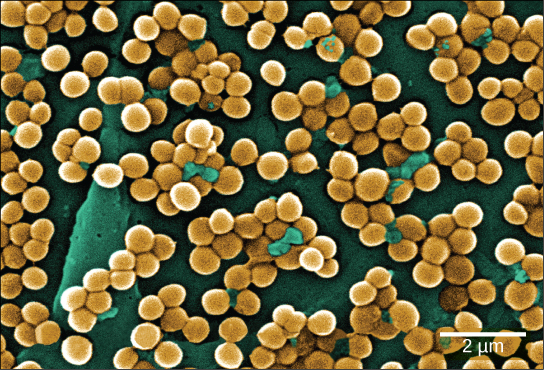| << Chapter < Page | Chapter >> Page > |
The imprudent use of antibiotics has paved the way for bacteria to expand populations of resistant forms. For example, Staphylococcus aureu s, often called “staph,” is a common bacterium that can live in the human body and is usually easily treated with antibiotics. A very dangerous strain, however, methicillin-resistant Staphylococcus aureus (MRSA) has made the news over the past few years ( [link] ). This strain is resistant to many commonly used antibiotics, including methicillin, amoxicillin, penicillin, and oxacillin. MRSA can cause infections of the skin, but it can also infect the bloodstream, lungs, urinary tract, or sites of injury. While MRSA infections are common among people in healthcare facilities, they have also appeared in healthy people who haven’t been hospitalized but who live or work in tight populations (like military personnel and prisoners). Researchers have expressed concern about the way this latter source of MRSA targets a much younger population than those residing in care facilities. The Journal of the American Medical Association reported that, among MRSA-afflicted persons in healthcare facilities, the average age is 68, whereas people with “community-associated MRSA” ( CA-MRSA ) have an average age of 23. Naimi, TS, LeDell, KH, Como-Sabetti, K, et al. Comparison of community- and health care-associated methicillin-resistant Staphylococcus aureus infection. JAMA 290 (2003): 2976–84, doi: 10.1001/jama.290.22.2976 .

In summary, the medical community is facing an antibiotic crisis. Some scientists believe that after years of being protected from bacterial infections by antibiotics, we may be returning to a time in which a simple bacterial infection could again devastate the human population. Researchers are developing new antibiotics, but it takes many years to of research and clinical trials, plus financial investments in the millions of dollars, to generate an effective and approved drug.
Prokaryotes are everywhere: They readily colonize the surface of any type of material, and food is not an exception. Most of the time, prokaryotes colonize food and food-processing equipment in the form of a biofilm. Outbreaks of bacterial infection related to food consumption are common. A foodborne disease (colloquially called “food poisoning”) is an illness resulting from the consumption of contaminated food, or the pathogenic bacteria, viruses, or other parasites that contaminate food. Although the United States has one of the safest food supplies in the world, the U.S. Centers for Disease Control and Prevention (CDC) has reported that “76 million people get sick, more than 300,000 are hospitalized, and 5,000 Americans die each year from foodborne illness.”

Notification Switch
Would you like to follow the 'Principles of biology' conversation and receive update notifications?